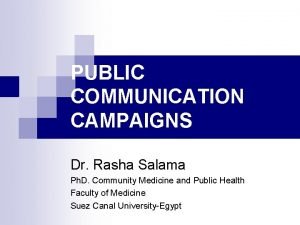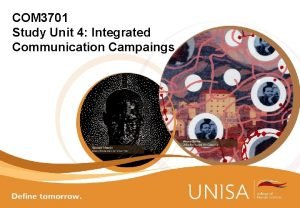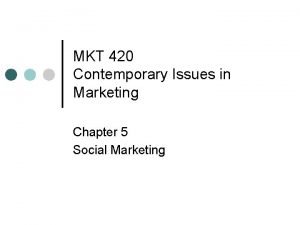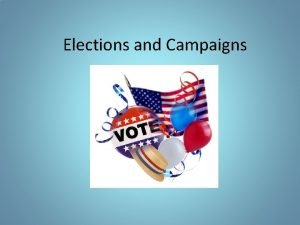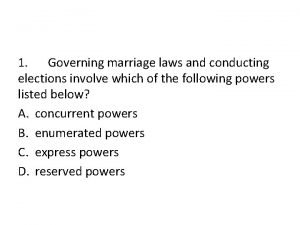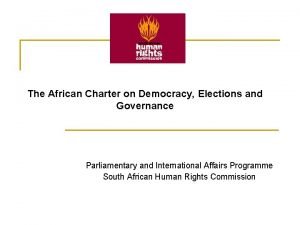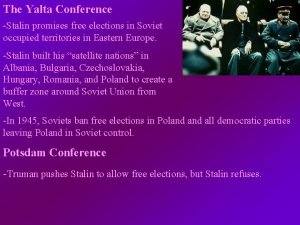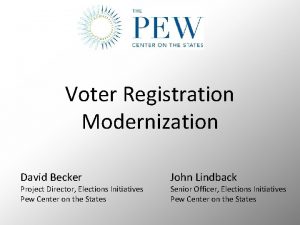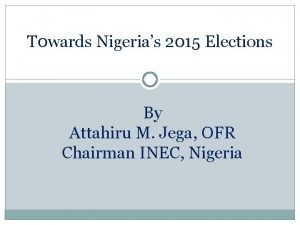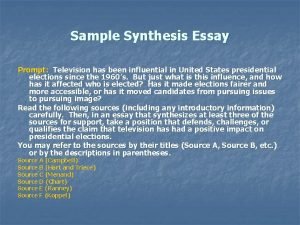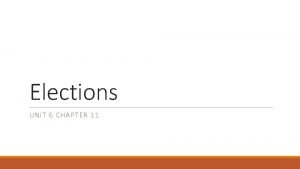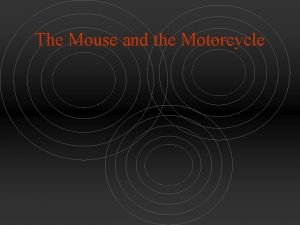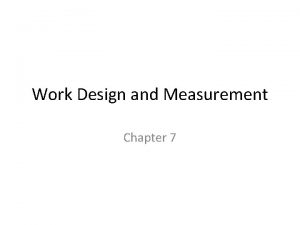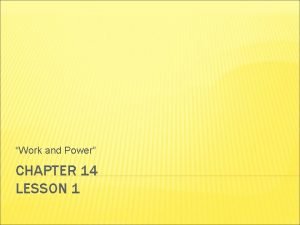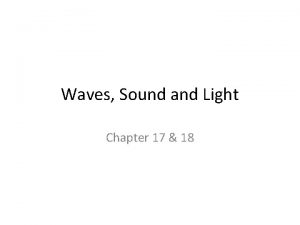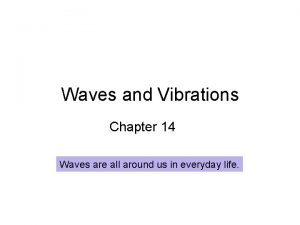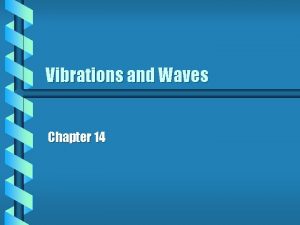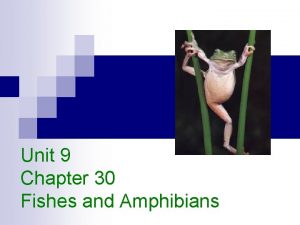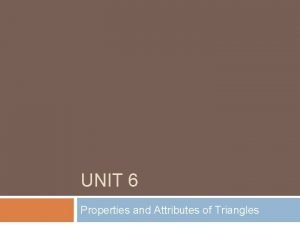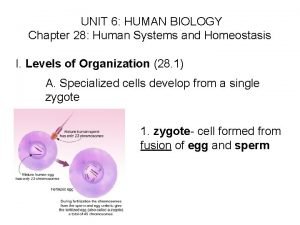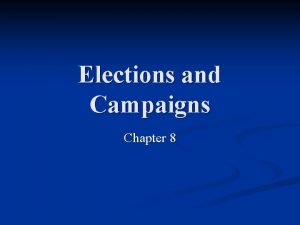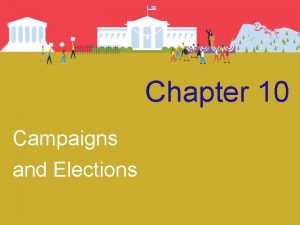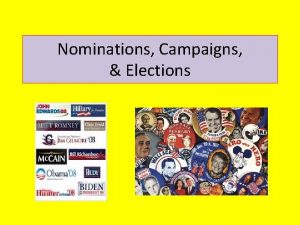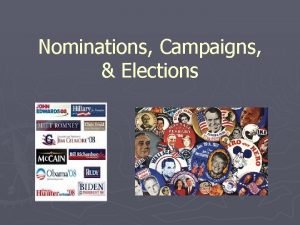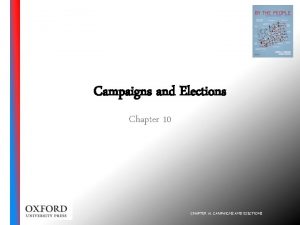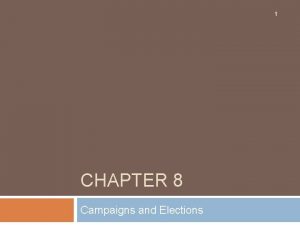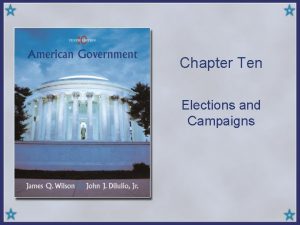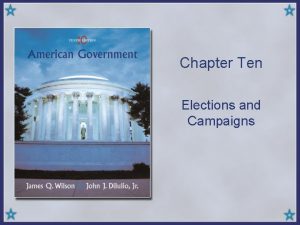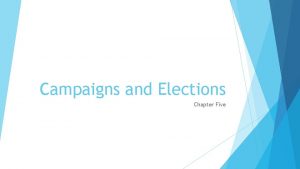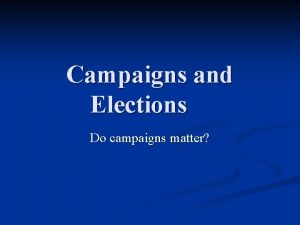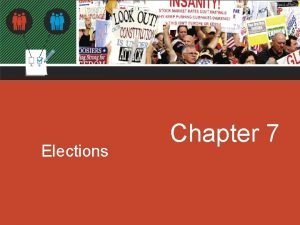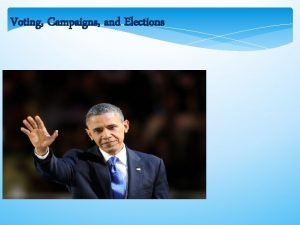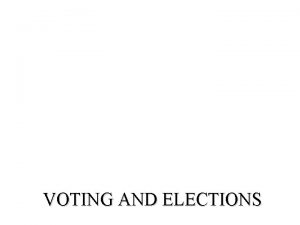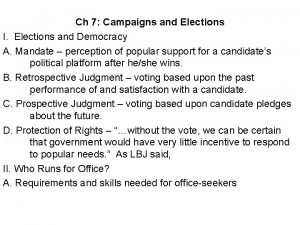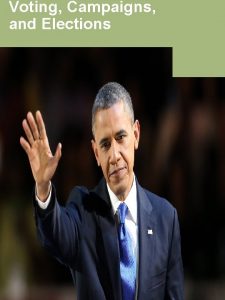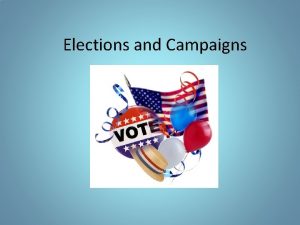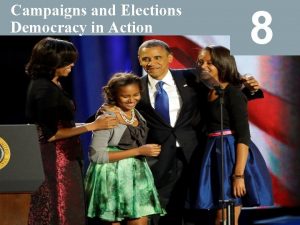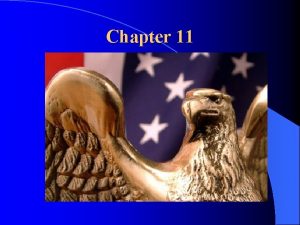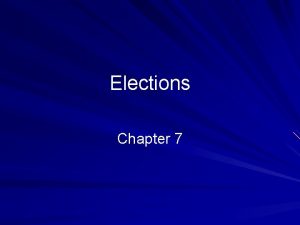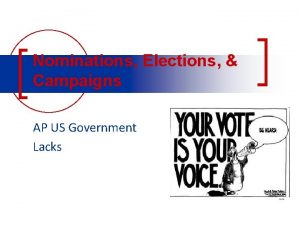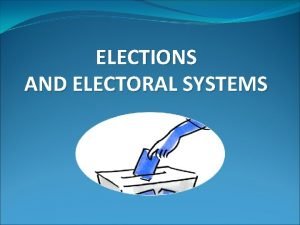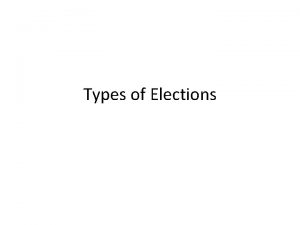Chapter 10 Campaigns and Elections Campaigns and Elections





























































- Slides: 61

Chapter 10 Campaigns and Elections

Campaigns and Elections

Elections in America • Presidential elections: held every four years on the first Tuesday in November • Congressional elections: held every two years on the first Tuesday in November

Elections in America • The Constitution gives states control over elections within their borders. • Localities typically administer elections. • Elections are overseen by state regulators.

Types of Elections • Four types of elections: – – Primary General Runoff Referendum elections • Proposed laws placed on the ballot for statewide vote

Types of Elections Primaries • Parties choose candidates who will run in the general elections. – Primaries do not elect people to office. • Open vs. close primaries • Voters can participate in either party primary, or not. • Voters do, or do not register, with party affiliations. • States may have caucuses; members meet and vote in the open.

Types of Elections • General elections – Determine who gets to hold office – Typically draws the most voters • Runoff elections – If a candidate does not win a majority in the general election, some states hold a runoff between the two highest vote-getters.

Types of Elections Direct democracy – Legislative referenda: all 50 states’ legislature refers policy to the public for a popular vote. – Popular referenda and initiative: 24 states, citizens petition to place issues on the ballot for a vote. • Bypass the legislature • Often controversial and/or expensive policies – Recall elections: 18 states, citizens vote to remove elected official from office.

Criteria for Winning • Majority vote: to win, the candidate must receive at least 50 percent of the votes, plus one. • Plurality vote: the candidate with the greatest number of votes wins. – Most American elections are plurality vote. • President (W. ) Bush did not get 50 percent of the vote in 2000. • President Clinton did not reach 50 percent in either of his elections.

Ballots • Different types of ballots – States decide which types they will use. • State ballot variations include: – – Straight-ticket option on ballot Party affiliations not listed Ballots available in multiple languages Voting machines, paper ballots, punch cards, or touch screens, mail only

Electoral Districts

Electoral Districts • Redistricting: congressional, state legislative districts drawn every 10 years (after Census). • Who draws districts? Varies by state. • Legislatures, nonpartisan committees, bipartisan committees, courts, panels, wide range. • Most districts gerrymandered to serve a particular party’s interest. – Both parties attempt to draw districts that maximize the probability of their party winning.

Electoral Districts • Three types of gerrymandering – Packing: ramming many voters of one party into a district to dilute their votes in other districts. – Cracking: tearing up dense pockets of party voters to dilute their votes in that district. – Stacking: merging two districts of the same party to force incumbents to run against each other.

Electoral Districts

Electoral Districts • Court’s fundamental district criteria for congressional districts: 1. Contiguous 2. Compact 3. Consistent with existing political subdivisions • Race can no longer be the deciding criterion. – Minority-majority districts often occur by way of residential patterns/population distribution.

Electoral College • Founders created electoral college because citizens were not trusted to make a good decision. – Even today, citizens do not directly vote for president, but rather for electors. • State electoral votes = number of U. S. Representatives + Senators (2) • All states but Maine and Nebraska allocate all electors to the popular vote winner.

WHO ARE AMERICANS? Who Supported Obama in 2012? CHAPTER 10

WHO ARE AMERICANS? Election Results by State’s Population Mitt Romney (R) Barack Obama (D)

WHO ARE AMERICANS? Votes in Electoral College

Electoral College • The electors vote at their respective state capitols the first Monday after the second Wednesday in December. • If no candidate has a majority of the electoral votes, the House decides the result, with each state getting one vote. • Ceremonial, traditional, but required events – No reason to expect an outcome opposite the electoral college

The Electoral College

Election Campaigns • Campaigns: efforts by candidates and their supporters to win support from donors, activists, and voters in quest for political office. • The first step: allow candidates to start raising money and accepting donations. • Two methods: – Form an exploratory committee – File papers announcing candidacy

Election Campaigns • Before anyone holds office, they have to run and they have to win. • Campaigns are how they run and win. – Strategies depend on office, party, candidate, contemporary issues, electorate, technology • Many-step process; higher offices have more steps and larger scale • Money, endorsements, and number appearances

Campaign Organization Chart

Election Campaigns • Advisers – Professional strategic decisions about organization, budgeting, executing the campaign • Fund-Raisers – Identify donors, find allies for indirect spending • Polling – Test ad messages, find out what voters think of them and opponents (strengths/weaknesses), push polls

Election Campaigns • Media – Strategic decisions: program appearances, spokespeople/campaign surrogates, message focus to convey to public – Prepare for high-coverage events like debates and conventions with extensive news coverage. – Rapid response teams to diffuse opponent attacks – Online: ads, fund-raising, event updates

Election Campaigns • Mobilization – Strategic decisions: where to invest money on advertising, number of candidate events – Collaborate with party, interest groups, state and local supporters online and in-person – Since 2008, significant mobilization occurs online where campaigns and supporters coordinate efforts and resources more efficiently.

Average House Campaign Expenditures, 1980– 2010

Average Senate Campaign Expenditures, 1980– 2010

The 2012 Primaries • Several Republicans vie for party nomination – January field included: Bachmann, Cain, Gingrich, Perry, Romney, Santorum – Twelve national debates over the course of a few months, record number – May: Romney effectively wins nomination, all others dropped out of the race • Democrats did not have a primary – Sitting presidents rarely challenged in modern era

Election Campaigns • Primaries – Formal process varies by party, state, and from election cycle to the next • Parties make their primary rules, frequent changes – Primary candidates and the public • Personal traits highlighted • Fewer policy ideology clashes(same party after all) • Media and activists most attuned – General electorate is very different than primary. – People who care a great deal about politics follow.

Presidential Elections • Parties select their presidential candidates by delegates sent from each state. – GOP: winner-take-all; DEM: proportional • Primary season is earlier each election. – States earlier on calendar are more influential • More media coverage, campaign mobilization • Many states have primaries after a nominee has been determined (challengers withdrew from race).

Presidential Elections • Contemporary party conventions – – Ratify the decisions made in primaries Enact any new rules for future delegate selection Draft party platforms Present candidates and party platforms to voters

How Voters Decide • Three main factors – Partisanship – Issues and policy concerns – Candidate characteristics

How Voters Decide • Most voters who identify with a party vote for that party’s presidential candidate

Consumer Confidence and Presidential Elections

How Voters Decide • Partisanship – People with strong party identification vote at higher rates, even if the contest is not competitive. • Issues are relevant when candidates take different positions. – Campaigns highlight differences they think are most important to voters. • Candidate characteristics – Personality, career, perceived things in common

Candidate Characteristics

Sources of Campaign Funds

Public Funding

Top Donors to 527 Committees, 2008

Public Opinion Poll Do you think voters make decisions based on the influence of campaign ads? a) Yes b) No, people already know who they prefer before seeing the ads.

Public Opinion Poll The redistricting process is controversial and conducted differently in each state. Who should draw district lines? a) State legislatures b) Nonpartisan state demographers, using only population data and maps c) A bipartisan committee of elected officials and public interest groups d) Appointed bipartisan panel of state judges

Public Opinion Poll Should the Democratic and Republican parties have a national primary to select their party’s presidential nominees instead of a state-by-state system? a) Yes, one national primary would be better. b) No, a state-by-state system is best.

Public Opinion Poll Should there be limits on the amount of money candidates can spend on campaigns? a) Yes b) No

Public Opinion Poll Should we get rid of the electoral college, or change the way that it operates (using the Maine or Nebraska models)? a) End the electoral college, and elect presidents by popular vote. b) Change to a less rigid system like Nebraska and Maine have implemented. c) Keep the current system in place.

Chapter 10: Campaigns and Elections • Quizzes • Flashcards • Outlines • Exercises wwnorton. com/we-the-people

Following this slide, you will find additional images, figures, and tables from the textbook.

Elections in America

Types of Elections

Presidential Elections

Direct Democracy Elections

Advisers

Fund-Raising

Digital Citizens

Electing the President: Steps in the Process

Electing the President: Steps in the Process

American Campaign Techniques Conquer the World

The 2012 Elections

The 2012 Elections

Sources of Campaign Funds
 Rasha salama
Rasha salama Interactive model of communication campaigns four phases
Interactive model of communication campaigns four phases International marketing campaigns
International marketing campaigns Informed delivery campaigns
Informed delivery campaigns Post campaign analysis presentation
Post campaign analysis presentation Strategic brand communication campaigns
Strategic brand communication campaigns 420 marketing campaigns
420 marketing campaigns Fast food campaigns
Fast food campaigns Presidential elections exploration and announcement
Presidential elections exploration and announcement Governing marriage laws and conducting elections involve
Governing marriage laws and conducting elections involve African charter on democracy, elections and governance
African charter on democracy, elections and governance Stalin promise free elections
Stalin promise free elections David becker elections
David becker elections Conclusion on elections
Conclusion on elections Ap lang synthesis essay television presidential elections
Ap lang synthesis essay television presidential elections “elections are key to democracy”
“elections are key to democracy” Chapter 7 ionic and metallic bonding chapter answer key
Chapter 7 ionic and metallic bonding chapter answer key Chapter 7 ionic and metallic bonding chapter answer key
Chapter 7 ionic and metallic bonding chapter answer key Properties of ionic compounds
Properties of ionic compounds Chemistry chapter 7 ionic and metallic bonding
Chemistry chapter 7 ionic and metallic bonding Representative metal
Representative metal The red tent summary chapter by chapter
The red tent summary chapter by chapter Great gatsby summary
Great gatsby summary Chapter 10 chemical reactions answer key
Chapter 10 chemical reactions answer key Chapter 11 study guide stoichiometry
Chapter 11 study guide stoichiometry Chapter 9 chemical reactions answers
Chapter 9 chemical reactions answers Similarity ratio definition
Similarity ratio definition Chapter 6: career readiness
Chapter 6: career readiness Chapter 9 surface water chapter assessment answer key
Chapter 9 surface water chapter assessment answer key Chapter 2 study guide representing motion
Chapter 2 study guide representing motion Chemistry: the central science chapter 14 answers
Chemistry: the central science chapter 14 answers Population ecology section 1 population dynamics
Population ecology section 1 population dynamics Chapter 2 chapter assessment
Chapter 2 chapter assessment Facts about the philippian jailer
Facts about the philippian jailer What does nick think of gatsby when he first meets him?
What does nick think of gatsby when he first meets him? The giver chapter 3 and 4 questions and answers
The giver chapter 3 and 4 questions and answers Diversity and human needs and development
Diversity and human needs and development Chapter 10 motivating and satisfying employees and teams
Chapter 10 motivating and satisfying employees and teams Bridge to terabithia chapter 4 questions and answers
Bridge to terabithia chapter 4 questions and answers Animal farm chapter 3 pdf
Animal farm chapter 3 pdf Chapter 24 the immune and lymphatic systems and cancer
Chapter 24 the immune and lymphatic systems and cancer The mouse and the motorcycle lesson plans
The mouse and the motorcycle lesson plans Section 4 review physical science
Section 4 review physical science Is the individual internal process that energizes directs
Is the individual internal process that energizes directs The lymphatic capillaries are
The lymphatic capillaries are Chapter 27 world war 1 and the russian revolution
Chapter 27 world war 1 and the russian revolution Chapter 10 section 2 central america and the caribbean
Chapter 10 section 2 central america and the caribbean Chapter 7 work design and measurement
Chapter 7 work design and measurement Chapter 14 section 1 work and power
Chapter 14 section 1 work and power Glue
Glue Why study financial market
Why study financial market Chapter 20 weather patterns and severe storms
Chapter 20 weather patterns and severe storms Characteristics of mechanical waves
Characteristics of mechanical waves How to fix forks in waves
How to fix forks in waves Walk two moons quiz
Walk two moons quiz Chapter 18 visual merchandising and display
Chapter 18 visual merchandising and display Chapter 14 vibrations and waves
Chapter 14 vibrations and waves What is amphibia
What is amphibia Segment fg is the angle bisector of ∠efh.
Segment fg is the angle bisector of ∠efh. Chapter 28 human systems and homeostasis
Chapter 28 human systems and homeostasis Motion forces and energy
Motion forces and energy Shifters of supply
Shifters of supply
